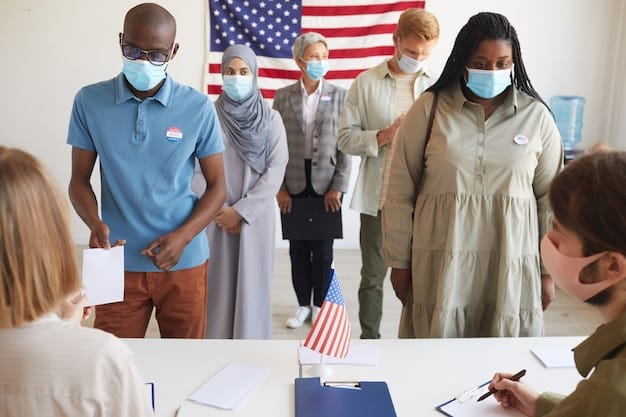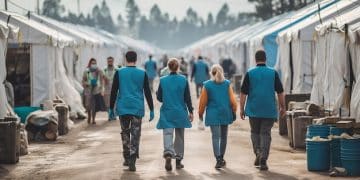UN Humanitarian Principles in Action: US Relief Operations

UN Humanitarian Principles in Action: Case Studies from Recent US Relief Operations examines how these principles are applied in practice during US-led relief efforts, ensuring aid reaches those in need impartially and effectively.
The landscape of international aid is complex, with numerous organizations and nations contributing to relief efforts around the globe. Among these, the United Nations (UN) plays a crucial role in coordinating and guiding humanitarian assistance. Central to the UN’s mission are the humanitarian principles: humanity, impartiality, neutrality, and independence. This article delves into UN Humanitarian Principles in Action: Case Studies from Recent US Relief Operations, exploring how these principles are upheld and implemented in practice during relief operations led by the United States.
Understanding UN Humanitarian Principles
Before examining specific case studies, it’s important to define the core principles that guide humanitarian action. These principles, endorsed by the UN General Assembly, provide a framework for ensuring that aid reaches those who need it most, regardless of their background or circumstances.
The Four Key Principles
The UN’s humanitarian principles are humanity, impartiality, neutrality, and independence. Each principle plays a vital role in ensuring that aid is delivered effectively and ethically.
- Humanity: Alleviating suffering wherever it is found, with particular attention to the most vulnerable.
- Impartiality: Providing assistance based solely on need, without discrimination.
- Neutrality: Not taking sides in conflicts or engaging in political controversies.
- Independence: Maintaining autonomy from political, economic, military, or other objectives.
These principles are not merely abstract ideals; they are practical guidelines that shape the decisions and actions of humanitarian organizations on the ground. They help to build trust with affected communities and ensure that aid is delivered in a way that respects the dignity and rights of all.
The principles provide the foundation for effective and ethical humanitarian action. By adhering to these principles, aid organizations can ensure that their assistance is focused on those who need it most and that it contributes to long-term recovery and resilience.

Case Study 1: Haiti Earthquake Relief (2010)
The 2010 earthquake in Haiti was a devastating event that claimed the lives of hundreds of thousands of people and left the country in ruins. The United States played a significant role in the relief effort, providing substantial financial and logistical support. Examining this operation through the lens of the UN humanitarian principles reveals both successes and challenges.
Applying Humanitarian Principles in Haiti
The US relief effort in Haiti was largely guided by the principles of humanity and impartiality. Aid was provided to those in need, regardless of their nationality, ethnicity, or political affiliation. However, maintaining neutrality and independence proved more challenging.
- Humanity: The immediate response focused on saving lives and providing essential supplies such as food, water, and shelter.
- Impartiality: Aid was distributed based on need, with efforts made to reach the most vulnerable populations.
- Neutrality: The US military’s involvement raised concerns about neutrality, as did the close relationship between the US government and some aid organizations.
- Independence: Some critics argued that the US relief effort was driven by political considerations, rather than solely by humanitarian needs.
Despite these challenges, the US relief effort in Haiti provided critical assistance to a country in desperate need. The operation demonstrated the importance of adhering to humanitarian principles, even in complex and politically charged environments.
The US relief effort in Haiti provided critical assistance with challenges in maintaining neutrality and independence. This operation highlighted the importance of upholding humanitarian principles, especially in complex situations.
Case Study 2: Typhoon Haiyan Response in the Philippines (2013)
In November 2013, Typhoon Haiyan, one of the strongest tropical cyclones ever recorded, struck the Philippines, causing widespread devastation and loss of life. The United States, in coordination with the UN and other international actors, launched a major humanitarian response. This case study examines how the humanitarian principles were applied in this context.
Coordination and Challenges
The US response to Typhoon Haiyan was notable for its strong coordination with the UN and other international aid organizations. This collaboration helped to ensure that aid was delivered efficiently and effectively. However, challenges remained in reaching remote areas and ensuring that aid reached the most vulnerable populations.
- Humanity: The US provided immediate assistance with search and rescue operations and the provision of essential supplies.
- Impartiality: Aid distribution was based on need, with efforts made to prioritize those who had lost their homes and livelihoods.
- Neutrality: The US military played a significant role in the response, but its activities were generally perceived as being neutral and impartial.
- Independence: The US worked closely with the Philippine government, but maintained its independence in terms of its operational decisions.
The response to Typhoon Haiyan demonstrated the importance of coordination and collaboration in humanitarian action. By working together with the UN and other international partners, the US was able to provide critical assistance to a country in crisis.
The quick US response demonstrated the importance of coordination and collaboration in humanitarian action, providing critical assistance during a crisis.

Case Study 3: Ebola Outbreak Response in West Africa (2014-2016)
The Ebola outbreak in West Africa was a major public health crisis that claimed thousands of lives and threatened to destabilize entire countries. The United States, working with the UN and other international partners, played a key role in the response.
Focus on Supporting Local Capacity
The US response to the Ebola outbreak was characterized by its focus on supporting local capacity and strengthening health systems. This approach was in line with the humanitarian principles of humanity and independence.
- Humanity: The US provided medical assistance, training, and equipment to help contain the spread of the virus and treat those who were infected.
- Impartiality: Aid was provided to all affected communities, regardless of their ethnic or political background.
- Neutrality: The US response was focused solely on addressing the public health crisis, without taking sides in any political disputes.
- Independence: The US worked closely with local governments and health organizations, but maintained its independence in terms of its operational decisions.
The Ebola outbreak response demonstrated the importance of building local capacity and empowering communities to take ownership of their own health. By working with local partners, the US was able to make a significant contribution to containing the outbreak and preventing further loss of life.
The US response to the Ebola outbreak focused on supporting local capacity and empowering communities. This demonstrated the importance of local partnerships in disaster relief.
Challenges in Upholding Humanitarian Principles
While the UN humanitarian principles provide a valuable framework for guiding relief operations, they are not always easy to uphold in practice. Numerous challenges can arise, particularly in complex and politically charged environments.
Balancing Neutrality and Engagement
One of the biggest challenges is balancing the principle of neutrality with the need to engage with governments and other actors in order to deliver aid effectively. In some cases, this may require compromising on neutrality in order to gain access to affected populations.
Aid organizations need to navigate complex political environments to deliver aid while upholding neutrality. Compromises are sometimes necessary to access those in need.
Addressing Security Concerns
Another challenge is addressing security concerns. In conflict zones, aid workers may face threats from armed groups or criminal elements. This can make it difficult to deliver aid safely and effectively. Balancing security with humanitarian principles to ensure aid workers’ safety is essential for effective operations.
Ensuring Accountability
Ensuring accountability is also crucial. Aid organizations must be transparent and accountable to both donors and affected communities. This can be challenging, particularly in large-scale operations where it may be difficult to track how aid is being used. Transparency is necessary. Aid organizations’ transparency on how aid is being used builds trust and accountability.
Lessons Learned and Best Practices
Despite the challenges, there are many lessons that can be learned from past relief operations. By identifying and implementing best practices, aid organizations can improve their effectiveness and ensure that aid reaches those who need it most.
Enhancing Coordination
One of the most important lessons is the need for enhanced coordination. This includes coordination between different aid organizations, as well as coordination with governments and other actors. When different organizations and governments coordinate and collaborate, aid can be delivered efficiently and effectively.
Investing in Local Capacity
The importance of investing in local capacity is another key lesson. By supporting local organizations and empowering communities to take ownership of their own development, aid organizations can help to build resilience and promote long-term sustainability. Supporting local organizations and communities leads to resilience and promotes long-term sustainability.
Strengthening Accountability Mechanisms
Strengthening accountability mechanisms is also essential. This includes establishing clear standards for aid delivery, monitoring and evaluating the impact of aid programs, and providing channels for feedback and complaints. Aid organizations provide feedback channels that strengthen accountability mechanisms and empower communities.
| Key Point | Brief Description |
|---|---|
| 🤝 Understanding Humanitarian Principles | Humanity, impartiality, neutrality, and independence are key. |
| 🌍 Haiti Earthquake Relief (2010) | Focus on immediate aid with challenges in maintaining neutrality. |
| 🌀 Typhoon Haiyan Response (2013) | Strong coordination with the UN, and quick assistance. |
| ⚕️ Ebola Outbreak Response (2014-2016) | Support local capacity and community ownership for health. |
FAQ
▼
The UN Humanitarian Principles are humanity, impartiality, neutrality, and independence. These guide humanitarian action globally.
▼
Neutrality ensures that aid is not used to favor any side in a conflict, building trust with all parties.
▼
The US adheres to impartiality by providing aid based on need alone, without discrimination or bias.
▼
Political and economic pressures can challenge independence, requiring clear ethical guidelines.
▼
Coordination ensures that aid is delivered efficiently, avoiding duplication and maximizing impact on affected communities.
Conclusion
In conclusion, the UN humanitarian principles provide a vital framework for guiding relief operations around the world. While challenges exist in upholding these principles in practice, the case studies examined in this article demonstrate the importance of adhering to them as closely as possible. By learning from past experiences and implementing best practices, the US and other aid organizations can improve their effectiveness and ensure that aid reaches those who need it most.





